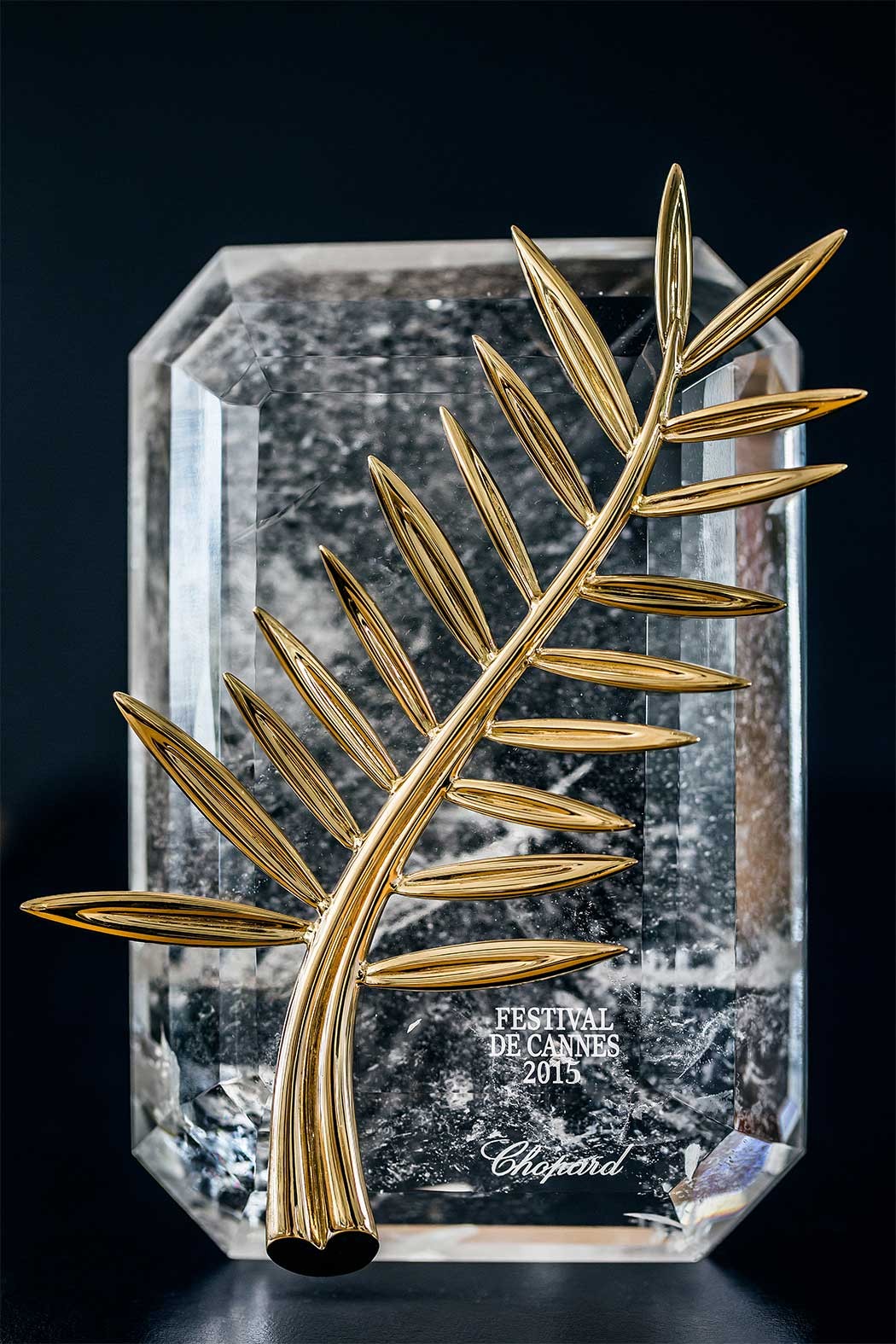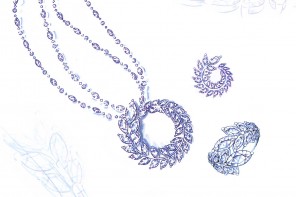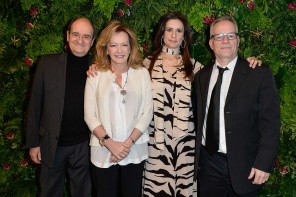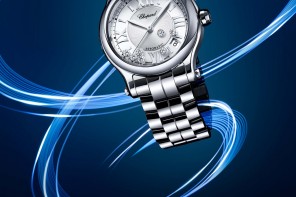Enduring symbol of the Cannes Film Festival, veritable grail for every film producer on the planet, the Palme d’Or award for the best film in the official competition is celebrating its 60th Anniversary this year. But the Palme d’Or has not always been in the guise in which we know it today. This supreme award has experienced several transformations since the creation of the Festival, prior to attaining its most noble and successful form in the Chopard workshops.
In fact, until 1954, the Jury of the Festival awarded a “Grand Prix du Festival International du Film” (International Film Festival Grand Prix) to the best director of the nominated films. The laureates were then presented with a work by a fashionable contemporary artist, such as figurative paintings or Sèvres vases. The Palme d’Or was not yet born. In 1954, the Executive Director at the time, Robert Favre Le Bret, invited jewellers to present designs of trophies inspired by the palm motif, in reference to the palm trees on La Croisette as well as the city’s coat-of-arms, on which the palm evokes the famous legend of Saint Honorat. When, around the year 1000, the village of Cannes was relinquished to the Abbey of Lérins located on the island of Saint Honorat off its coast, the palm, which was the Abbey’s emblem also became that of the city. A proud, victorious palm, symbolising the palm tree that Saint Honorat climbed so that the sea could cleanse the island of the snakes with which it was infested. The winning project was that of jewellery designer Lucienne Lazon who, according to another legend, designed her Palme together with Jean Cocteau, who was then the President of the Jury and an advisor.
Birth of a legend
In 1955, the first Palme d’Or, awarded to Delbert Mann for Marty, was born at the same time as another myth: Brigitte Bardot. But in 1964, following contestation, it disappeared for ten years and the Festival returned to its Grand Prix and certificate approach. In 1968, the events that took place in May stopped the festivities. For the first time in the entire history of the Festival, no awards were made. In 1974, Francis Ford Coppola was the last person to leave with a work of art, accompanied by a huge, very cumbersome certificate, for his film, The Conversation.
It was not until 1975 that the Palme reappeared under the impetus of Maurice Bessy, then Executive Director, who wished to reinvigorate the sparkling symbol, nestled in a red full-grain Moroccan leather box padded with white suede. At the beginning of the 1980s, the rounded shape of the pedestal on which it stood was slowly transformed into a pyramid. In 1992, Thierry de Bourqueney redesigned the Palme and its pedestal, which was now in hand-cut crystal.
The following year, for the first time in the history of the Festival, a woman was awarded the Palme d’Or. New Zealander Jane Campion remains to this day the only woman to have won the ultimate prize for her film, The Piano. Gilles Jacob, former President of the Festival, remembers: “Jane is a feminist, she pointed out that she was the first woman to receive the award. I nicknamed her ‘Lady Palme d’Or!’ ”
In 1997, on the occasion of the 50th anniversary of the Festival, a Palme des Palmes (Palm of Palms) was awarded to Ingmar Bergman for his work overall, attended by 28 other holders of the trophy.
That same year, while the Maison Chopard was preparing to open a boutique on La Croisette with prestigious patronesses including Eva Herzigova, Ornella Mutti and Carla Bruni, Chopard Co-President and Artistic Director, Caroline Scheufele, came up with the idea of inaugurating it during the Festival in order to create some synergy between the two events. She contacted the organisers to discuss possibly working together.
The two institutions have maintained close ever since and constantly reinforce their ties: “During my very first meeting with Pierre Viot, who was then President of the Festival” Caroline Scheufele reminisces, “I noticed the Palme d’Or just behind him in his office. I asked to have a closer look and seeing my keen interest, he asked if I would like to come up with a new version for him, a “makeover” of some sort. I was delighted and took on the task with great enthusiasm!”
Chopard’s Palme d’Or: a precious jewel for the most prestigious of awards
Caroline Scheufele decided to make the Palme d’Or lighter but to give it greater volume and depth, while emphasising the veins in the stalk and the regulation 19 leaves. She also designed the stalk so that it ended in the shape of a heart, one of Chopard’s jewellery emblems. In addition, as the Palme d’Or is the most coveted award in film-making, Caroline Scheufele wanted the trophy to be commensurate with that which it represents: for it to be precious in every sense of the term. While the 1998 and 1999 Palme trophies were made of vermeil, a silver substrate gilded with 30 microns of fine gold, the second millennium gave the Palme its golden blessing with 125 grams of 18-carat gold. Caroline Scheufele added another precious detail to it with a rock crystal pedestal carved like an emerald-cut diamond. The Palme d’Or was then presented in a royal blue Moroccan leather box. In 2001, after Lars Von Trier, wild with joy, brandished his Palme for Dancer in the Dark as high as he could and the trophy fell on the floor, a safety catch was added to the box.
Marc Couttet, director of Chopard’s Haute Joaillerie creation department, comments enthusiastically on this makeover: “The Palme has become dynamic, streamlined, joyful and loving with a heart sculpted at the base of its stalk, a very glamorous addition to its crystal bed! The rock crystal on which the Palme rests is more than a good backdrop or foil; it is the trophy’s twin ‘symbolon’ (two halves of one whole, one standing for the other). The hard, transparent, sometimes cloudy, material of which crystal is made, gives the award its unique aura. The flecks, inclusions, natural fractures and milky mists that are part of the gem’s natural make-up are disturbing, often revelatory signs of the atmosphere of the winning film or its director: limpid, icy, misty, torn, disturbed, clairvoyant…” Is the Palme endowed with visionary powers?
To obtain a crystal of the quality and size as that used for the trophy, Marc Couttet and his team start with a raw chunk weighing at least three kilos that has to be sawn, cut, shaped and polished during several operations. This is a costly preferential treatment that calls for highly qualified know-how ensuring a jewellery finish that the previous Palmes did not have. Its creation requires a total of seven craftsmen and around 40 hours of work, between making a wax model, hand-casting the plaster in a furnace at 760°C, injecting the gold into the mould, polishing, and finally securing it to the rock crystal pedestal.
Exceptional Palmes
It was also at the beginning of the second millennium that Caroline Scheufele took it upon herself to make amends for an injustice by manufacturing mini Palmes, perfect replicas of the big one, for the Best Actor and Actress awards, presented to the actors and actresses who up till then were simply given a certificate. In 2006, many more mini Palmes were required when Days of Glory (five actors) and Volver (six actresses) won the Best Actor/Actress award collectively!
And in 2013, the Palme d’Or itself had to be produced in triple when Steven Spielberg and his jury decided to award it to director Abdellatif Kechiche and his two actresses, Adèle Exarchopoulos and Léa Seydoux for Blue is the Warmest Colour.
“President Spielberg’s decision to reward exceptional actresses in an exceptional role by giving them the large Palme d’Or awards, normally exclusively reserved for the film itself was an exceptionally transgressive behaviour!” enthuses Gilles Jacob. Léa Seydoux has still not gotten over it: “I was very happy to be part of such a prestigious prize. I thought there might be an Best Actress award for Adèle or a Palme for the film but not this triple Palme d’Or. For me, it is recognition of the work achieved, on this film in particular; but also, on a more general level, it acknowledges a career to date. It is as if this Palme set a seal of approval on my choice to become an actress. It is the symbol of the Cannes Film Festival just as I imagined it to be when I was young and had no idea I would become an actress. The image of an incredible, mysterious, fairy-tale world. I see it every day, it has pride of place on my mantelpiece!”
Thierry Frémaux, Délégué Général of the Festival, describes the incomparable scope of a Palme d’Or in the following words: “Every remittance of a Palme is unique and wonderful. And I could count every moment of every year. When a Palme d’Or is awarded to a great master, as was the case for Malick, Haneke or Polanski, it is amazing because one has the feeling that the Cannes awards keep step with history. I hope that it will always be this grail that makes filmmakers dizzy with desire. May it continue to give its blessing to talent by rewarding great artists, or discovering who the promising filmmakers of tomorrow will be.”
A Palme d’Or with an enduring sparkle
In 2014, Chopard extended its commitment to the development of sustainable luxury which started with The Journey to Sustainable Luxury created with Livia Firth, founder of Eco-Age, and launched in May 2013 at the 66th Cannes Film Festival.
At this point, the watchmaker-jeweller decided to make the Palme d’Or out of ‘Fairmined’ gold, mined with respect for people and the environment. “I am delighted and proud that the Palme d’Or that I redesigned 17 years ago, this very powerful symbol that is known and recognised all over the world, can today be made of traceable gold, mined with respect for people and the environment,” says Caroline Scheufele.
Thierry Frémaux applauds: “The Cannes Film Festival is not held in isolation from the rest of the world. Behind the red carpet, the glamour and the exclusive passion of cinema, resounds an echo of our lives. The question of sustainable development is at the very heart of our concerns. Chopard’s idea to make a contribution through its ethical jewellery and the Palme’s ‘Fairmined’ gold is fundamental. We are delighted and proud that our partner has such strong views and such profound convictions.”
The first film to win a Chopard-made Palme d’Or was called Eternity and a Day. What a wonderfully premonitory association with a Palme d’Or that is so majestically… eternal.





